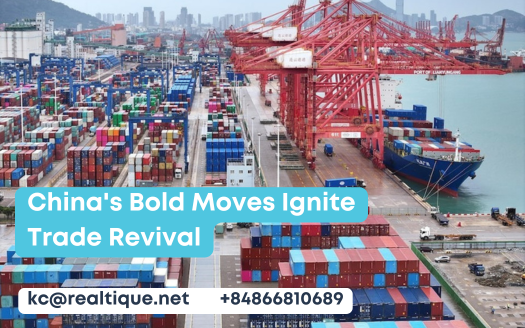China’s Bold Moves Ignite Trade Revival
China’s recent initiatives aimed at revitalizing trade reflect a calculated response to both domestic economic challenges and external pressures, particularly from the United States. By implementing innovative trade policies, such as lowering import tariffs and dismantling non-tariff barriers, the nation seeks to enhance foreign engagement and increase agricultural exports. These strategic shifts are not merely reactive; they signify a broader ambition to reshape global trade interactions. As these developments unfold, the implications for international markets and partnerships warrant careful examination. What might this mean for the future of global trade?
Table of Contents
Economic Stimulus Overview
In response to escalating trade challenges, China has implemented a series of strong economic stimulus measures designed to strengthen its domestic economy.
These initiatives include substantial financial support for businesses aimed at mitigating risks and stabilizing operations amid external pressures. By prioritizing targeted interventions, the government seeks to enhance employment and improve consumer confidence, essential components for sustained economic growth.
Financial products customized to the needs of enterprises are being introduced, ensuring liquidity and encouraging resilience. The overarching goal is to maintain a vigorous economic environment capable of withstanding external shocks while promoting domestic consumption.
As such, these measures represent a proactive approach to navigating complex trade situations and reinforcing the foundations of China’s economic stability.
Trade Policy Innovations
Recognizing the need for adaptability in a shifting global environment, China has introduced a series of innovative trade policies aimed at enhancing its foreign trade engagement.
These measures include increasing agricultural exports and reducing import tariffs to stimulate trade flows. Additionally, the government is addressing non-tariff barriers that hinder trade efficiency, thereby creating a more favorable atmosphere for export-oriented businesses.
By cultivating conditions that promote international trade, China aims to stabilize its economy and expand market access for its goods.
The implementation of these trade policy innovations is expected to attract foreign investment, strengthen competitive advantages, and ultimately enhance China’s position in the global marketplace, clearing the path for sustainable economic growth amidst changing international interactions.
Effects of U.S. Tariffs
The introduction of U.S. tariffs under the Trump administration has prompted significant shifts in China’s trade environment, particularly concerning its manufacturing exports.
The proposed 60% tariff on Chinese imports raised concerns about potential disruptions, with economic analysts predicting a GDP reduction of up to 1%. In response, many Chinese exporters are reevaluating production strategies and seeking alternative markets to mitigate the financial impact.
This shift has resulted in increased costs and heightened market volatility, urging businesses to adapt swiftly. Additionally, the tariffs have catalyzed a broader reevaluation of China’s trade dependencies, leading to an accelerated push towards diversifying export markets.
As a result, China’s manufacturing sector is undergoing substantial change to maneuver these new challenges effectively.
Strengthening Global Partnerships
China is actively pursuing strategies to strengthen its trade relationships with key global partners, particularly in light of shifting market forces.
The nation has focused on enhancing collaboration with the European Union, Australia, and various African countries, broadening its export markets as reliance on the U.S. diminishes.
In 2022, the U.S. accounted for only 15% of China’s total exports, a decline from the historical average of 18%.
This shift highlights China’s commitment to nurturing relationships with emerging markets, thereby creating a more balanced trade portfolio.
Future Trade Outlook
Amid changing global economic forces, significant growth in China’s export capabilities is anticipated over the coming years. Analysts predict that ongoing investment in trade-friendly policies will cultivate a sturdy trade environment, particularly as the country seeks to diversify its markets.
With a focus on enhancing agricultural exports and reducing import tariffs, China aims to create favorable conditions for export-oriented businesses. Additionally, strengthening international relations, particularly with the EU, Australia, and emerging markets, is expected to mitigate the impact of U.S. tariffs.
As global trade movements evolve, continuous adaptation to consumer demands and international trends will be essential for maintaining competitive advantages. Strategic planning will be vital to capitalize on these emerging opportunities and address potential challenges.





